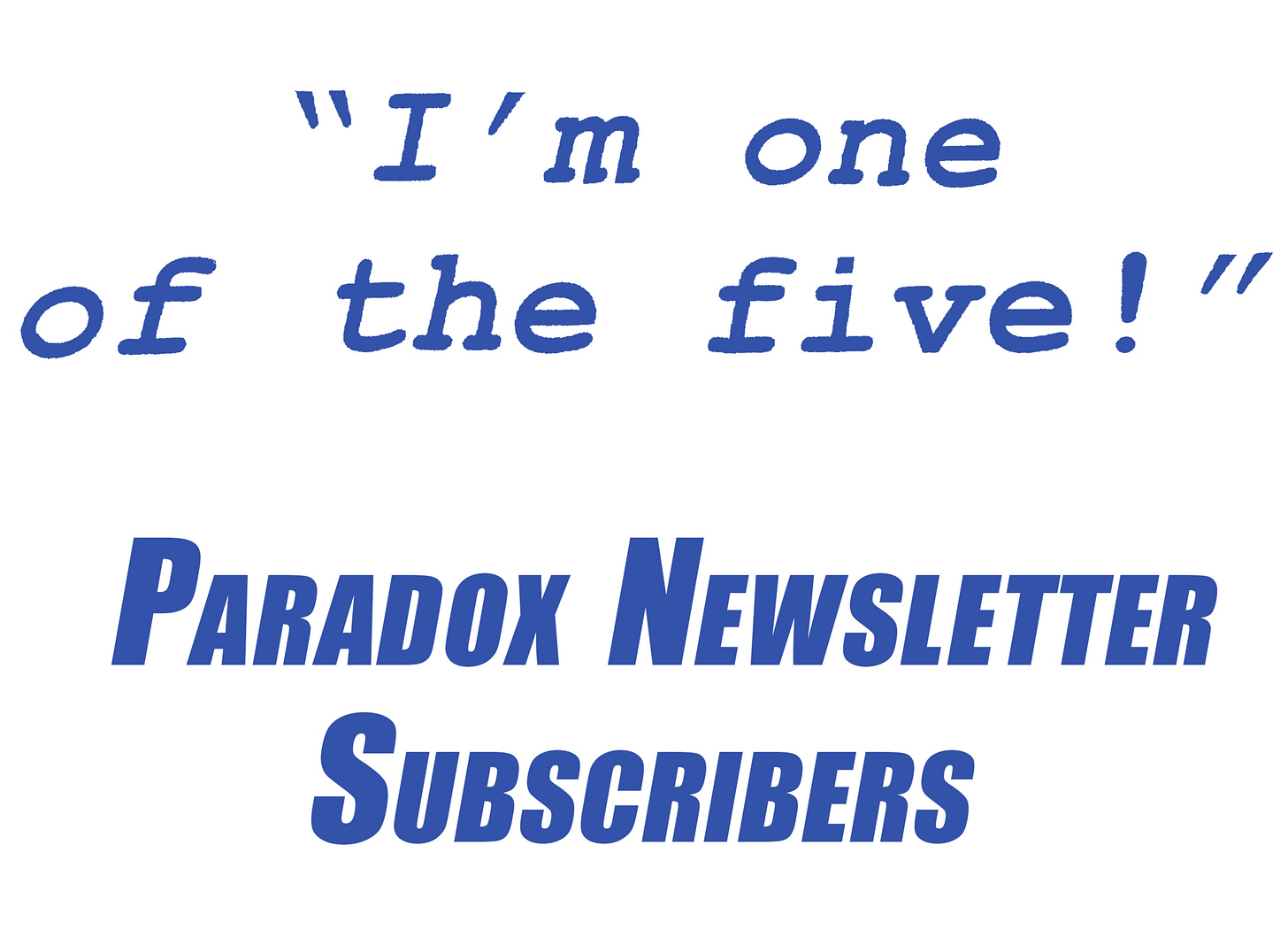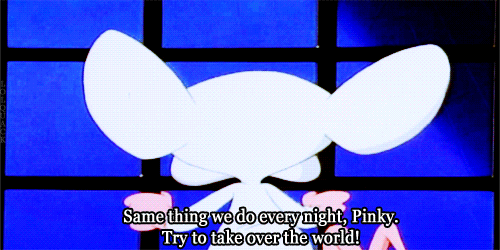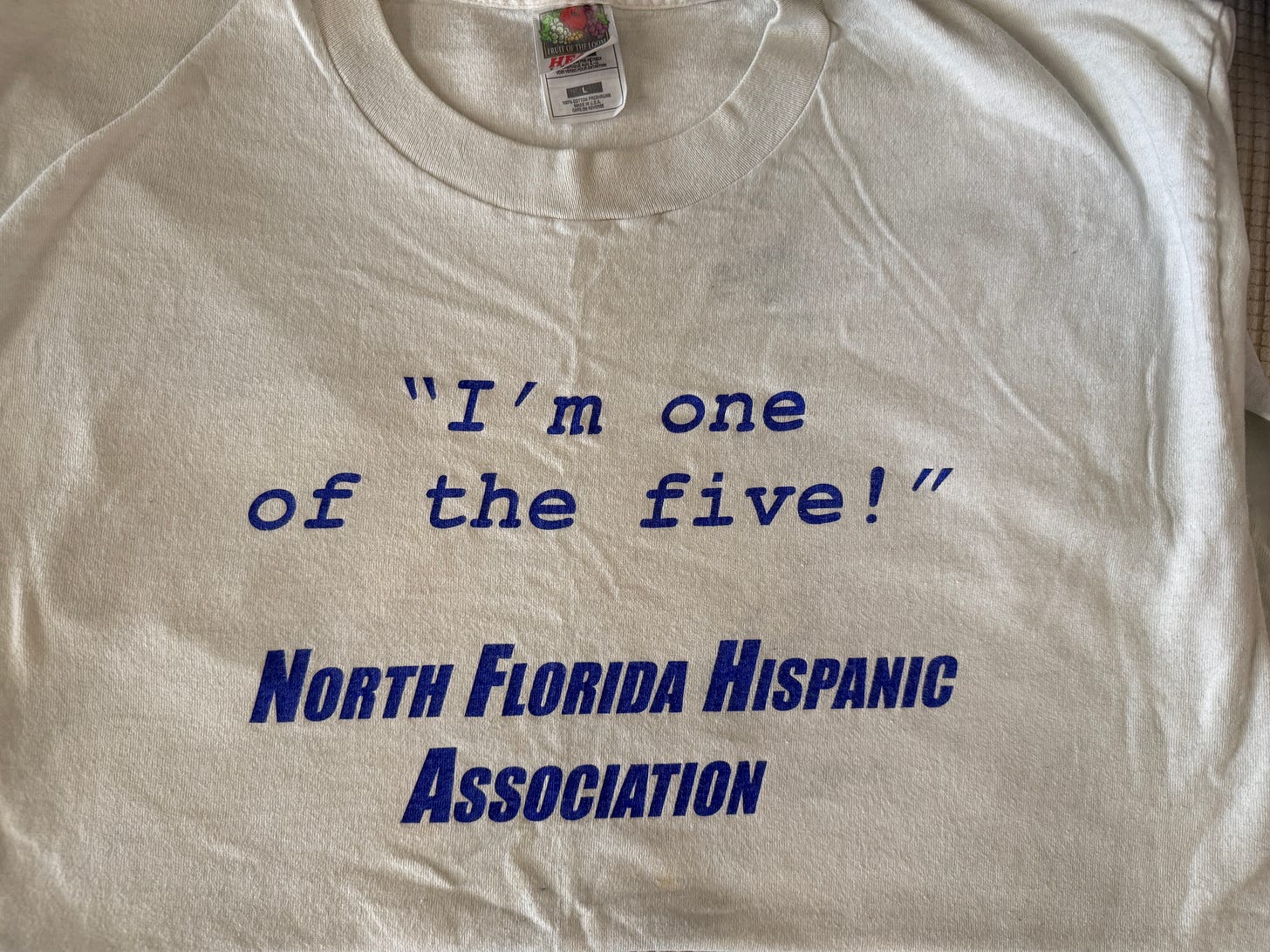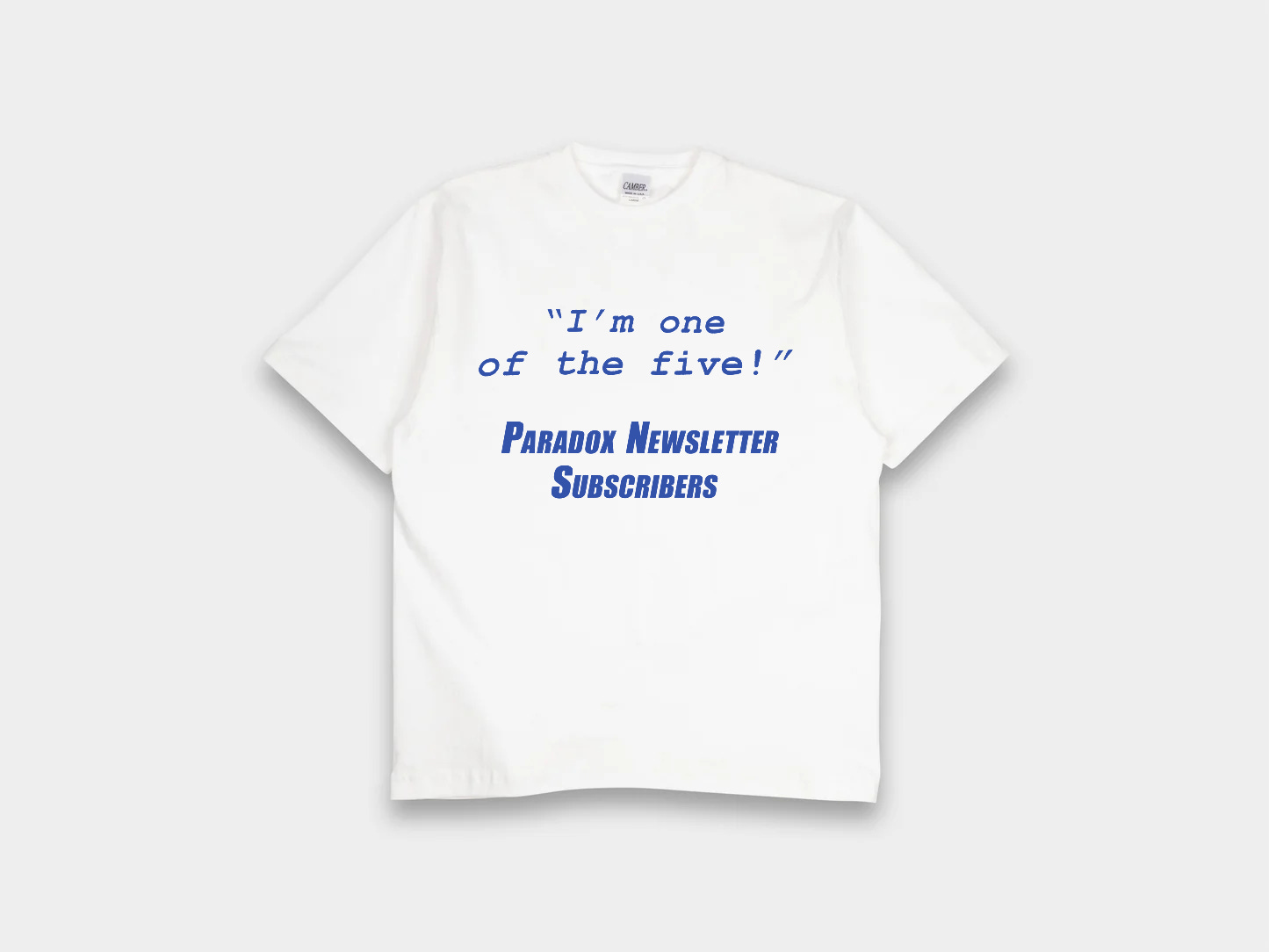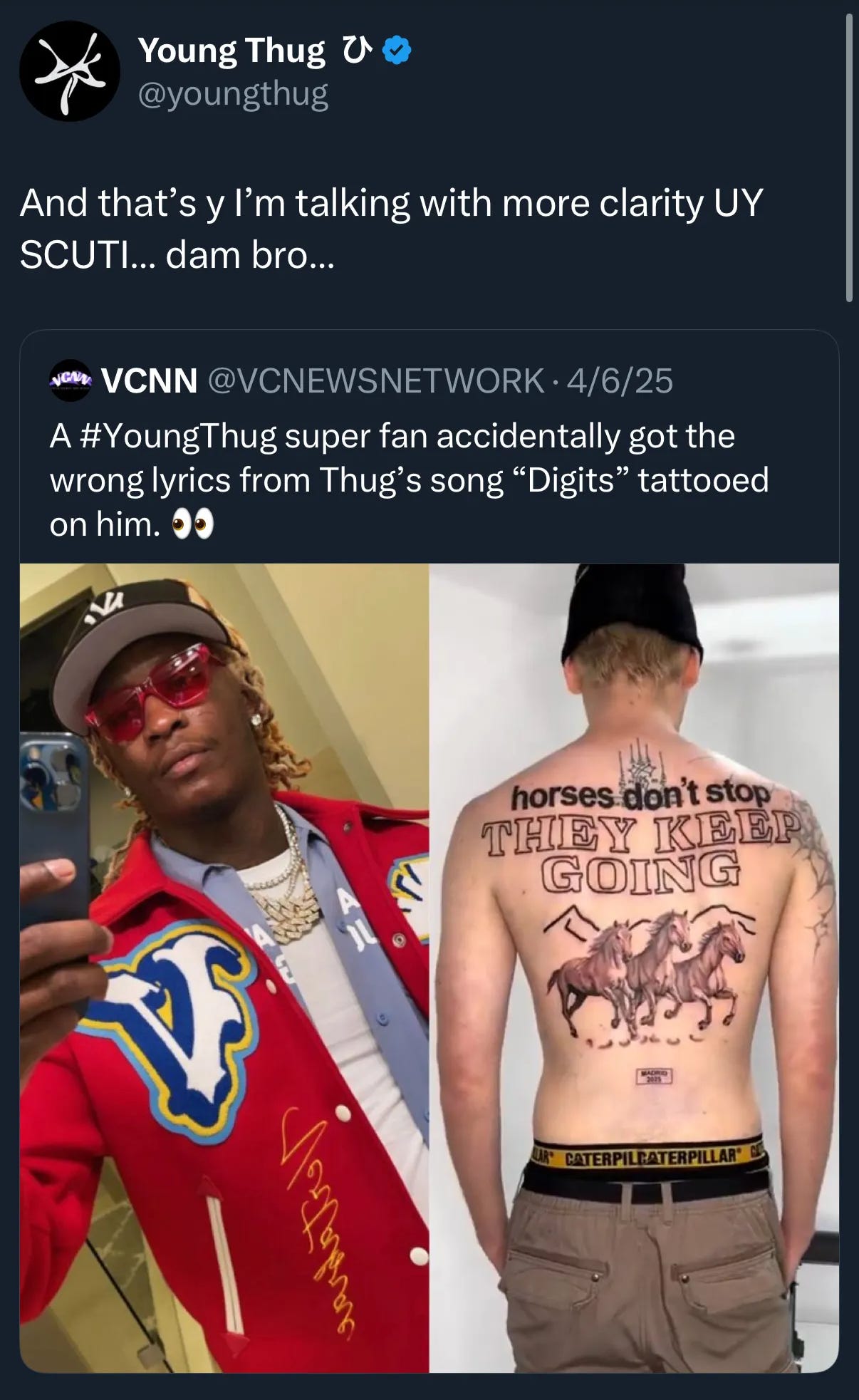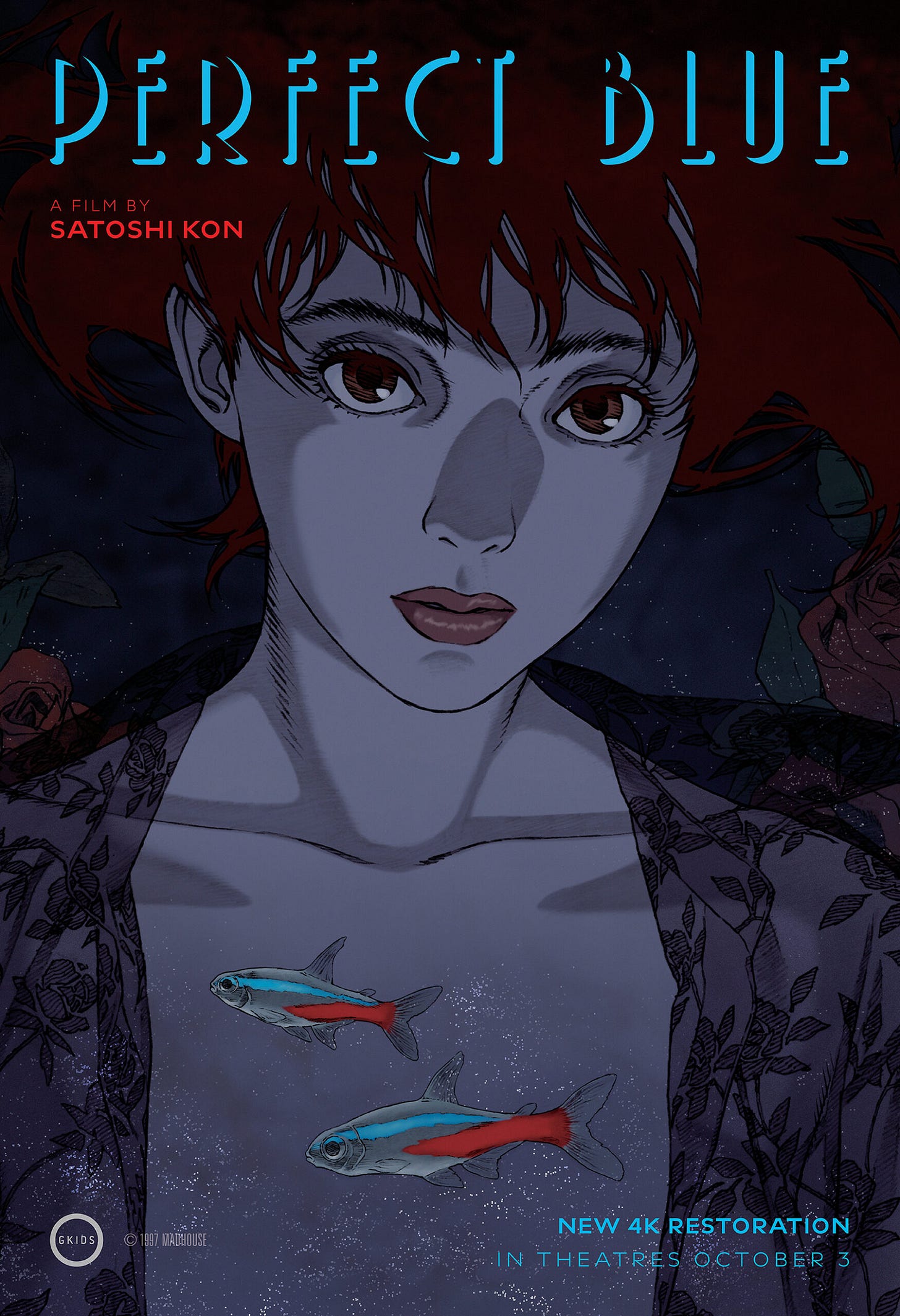Issue #400: UY SCUTI and Reflections on 400
This is issue #400. I usually don’t commemorate at the obvious intervals, but let’s put it in perspective. 400 newsletters is 400 weeks. More than seven years of writing Paradox. I did a few podcasts, a few zines. Screened some movies. Made 300 or so amateur photoshop header images with 50~ or so being made more professionally by Erin or Spencer. I got a few paid subscribers, a lot of unpaid. Would be nice to land a few more of those $5 a month commitments. It helps remind me this is worth doing and maybe, with enough dough, opens up some heretofore unimagined possibilities.
So, what’s next?
Always the same. More writing, more watching movies, more getting together online and in-person. More projects I probably haven’t thought of yet, more ideas for the newsletter I will start and stop. More contributors? Maybe.
400 newsletters barely missing a week. I live this shit. It’s hard to get eyes on what you do when you hate self-promoting but love writing. There’s a common phrase in artist and academic bios, that someone works at the intersection of something and something else. My joke is that I work at the intersection of what nobody understands and nobody cares about. The fact that I have any readers is a minor miracle. There are a lot of things that contribute to this fact, including your profound capacity for discernment and great taste. But every one of you is worth 100 TikTok or youtube subscribers.
I work at the intersection of what nobody understands and nobody cares about.
Jokes aside, there are good reasons to read my work. I try to write as well as I can. No matter how much you know, you will probably find something you don’t know in here. Remember what Lacan said in Seminar X about his own wide-ranging and unexpected allusions, “being educated is nothing less than guaranteed.” I write for someone to read it and feel a sense of relief and recognition that some idiosyncratic thing has been said or thought. But I won’t keep romanticizing the writing today.
As you know, as much as I like writing, I also like t-shirts. My dad was actually responsible for the creation of some pretty cool ones, like this:
I thought I had a pretty good grip on the backstory, but I have since learned a few key details. In 1998, Tallahassee, Florida mayor Scott Maddox delivered a speech at Georgia Bell Dickinson apartments. My grandmother (we called her ‘Nana’), Hilda Munoz, was among the audience and quoted Maddox to our local paper, and my dad. According to her, Maddox criticized Comcast’s offering of Univision in Tallahassee, posing a question about the demographic, “They even have a channel in Spanish for, what, the five Hispanics in Tallahassee?”
The news coverage by Lames L. Rosica reports my dad “blew a gasket” after hearing Maddox’s alleged comment. But the biggest headline is the shirt: “I’m one of the five!” It’s a response to what modern commentators might call an “erasure” of the Latino population in Tallahassee. If it was not already obvious to Maddox there were more than five “Hispanics” living in Tallahassee at the time, maybe the shirt would help.
Though I didn’t remember my Nana’s involvement, the story up to this point is more or less how I would have told it. What I didn’t remember at all, though, is that this story has an ending. After repeated slings and arrows, including additional coverage in our local paper, Maddox apologized. He also made a gesture: buying a shirt himself and wearing it during the Springtime Tallahassee parade. This parade was a big deal. My dad and Nana are all over the newspaper coverage, by Rosica and Bill Varian, which you can read here from Tallahassee Democrat editions published on 3/8/98, 3/16/98, and 4/12/98:

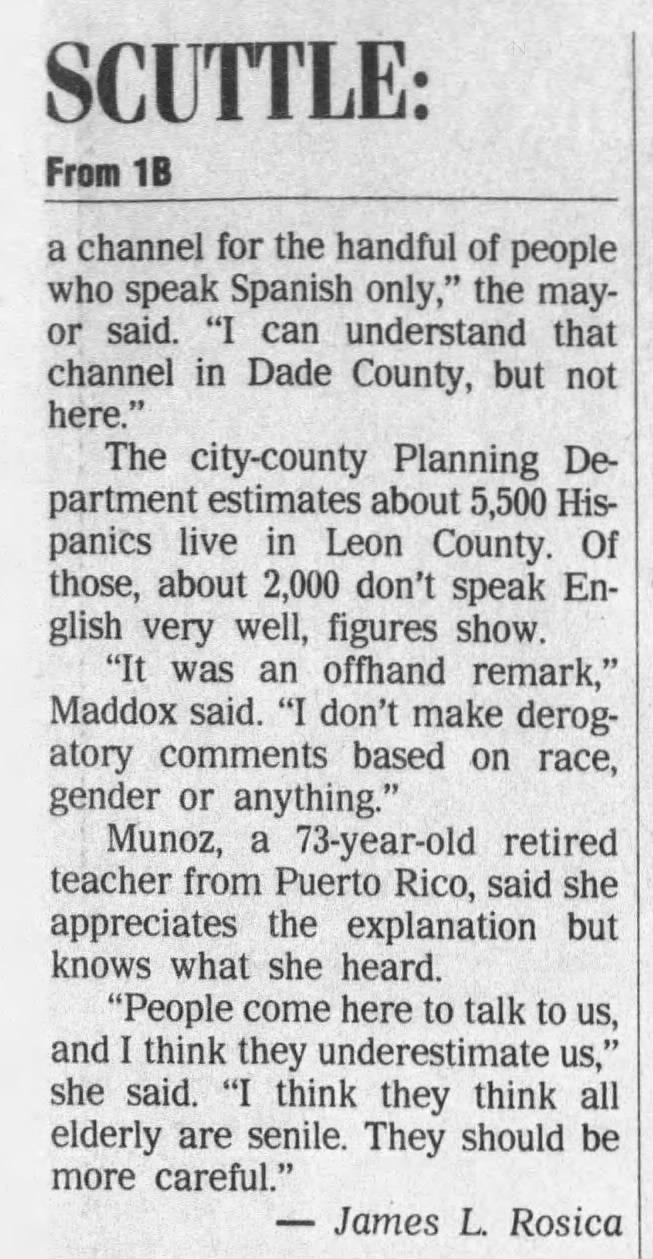
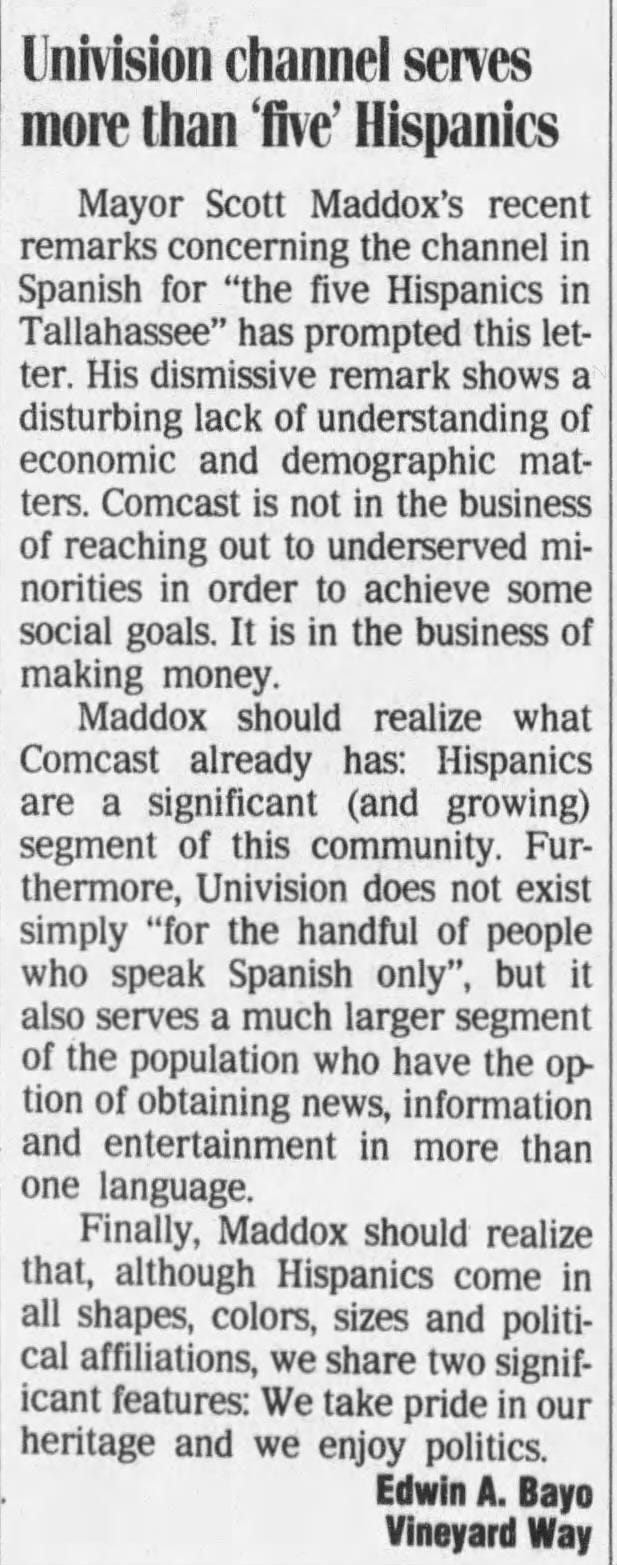

As a final twist and dagger to Maddox, he was indicted for various financial crimes in 2018. I don’t think any of them had to do with Univision. He got out of prison in 2023.
How does one honor thy father, the politically minded satirical t-shirt maker? Make a shirt, of course. My wife Erin primarily handled the photoshopping of this rip-off.
This is a special t-shirt. It is available only to paid subscribers. If you would like to buy one and you are not a paid subscriber, you know what to do.
If you are a paid subscriber, leave a comment, email me, post in the discord, whatever. In the DIY spirit of this newsletter, I am screen printing these myself. That means applying emulsion to mesh, burning the screen, applying ink to shirt, curing the print. I have only done the latter part of this process decades ago, so please expect longer than usual turnaround times. If you are a paid subscriber and want a shirt, it will cost you $10 plus shipping. If you are a paid subscriber and you want to mail me a shirt (or tote bag, or whatever) for me to print on, it will only cost you what it costs me to ship the shirt back to you. When you can, it is cool to do things yourself. If you have a creative project in mind, I encourage you to do it. Make the thing you want to make. Often, we are our own greatest obstacles.
Now, back to our regularly scheduled Music League coverage. As I discussed last week, this playlist is “Duets.”
There was, as always, a wide range of submissions. We still have a few outstanding voters so I can’t reveal mine just yet. I did really like the Julio Iglesias and Willie Nelson joint. There’s just something about a song two guys would come out under spotlights and sing on a Vegas casino stage that screams “duet” to me.
The Edward Maya/Vika Jiguilina song and Saint Etienne song were both ones I had heard before but didn’t recognize by name, so I was happy to have them both put in front of me again. Someone submitted “The Gray Race” by Bad Religion making the case it’s a duet between Greg Hetson and Brian Baker, the latter who had just joined the band. I can dig it.
This was the first round where we saw repeat artists and repeat songs. Both the Lydia Lunch and Nancy Sinatra versions of “Some Velvet Morning” made it, along with another Nancy Sinatra and Lee Hazlewood duet, “Sand.”
I think the deep well of musical knowledge is evident in this playlist. It’s one of the more enjoyable front to back that we’ve had so far. Next week is “Thanks, Mom and Dad” which calls for “songs that your parents listened to when you were a kid that you now love.” I already have my submission lined up.
Horses Don’t Stop, They Keep Going
Ryan Engley and Todd McGowan have a bit about mishearing lyrics in their December 21 2020 episode of Why Theory, “Popular Music.” Engley says, “famous film line mis-hearings … they get to the point” with McGowan later applying Engley’s idea to mishearing song lyrics:
You had this incredible image of what the other was doing. And then … you read … the actual lyrics. You’re like, well, ‘that’s not so great” … I mean, let’s talk about R.E.M. … Michael Stipe is a great example of the voice as object. So that’s a slightly different kind of encounter, right? Like, that’s a way in which your desire, you find your desire manifested in the object of the voice itself. And then the meaning or the signification always drops in the background to an R.E.M. song.
R.E.M., notorious as they are for misheard lyrics, pale in comparison to Young Thug, especially in the case of “Digits” (2016). The lyric, “hustlers don’t stop, they keep goin’” is often misheard as “horses don’t stop, they keep goin’” to the point that a Young Thug fan now has an extremely large back tattoo of horses along with the mistaken lyric.
Young Thug laments this mistake. But perhaps it is a great artistic achievement on his part. In the tweet, he refers to the then-forthcoming album UY SCUTI (2025) that released at the end of September. It is evocatively named for the supergiant star located in the constellation Scutum. While today it is considered among the largest stars, it is well below the solar radius measures of VY Canis Majoris, AH Scorpii, and Stephenson 2 DFK 2. AH Scorpii is an okay name, but UY Scuti seems tailormade for the title of a Thug record. The allegorical meaning is clear: Thug himself is also among the largest “stars” in music.
Young Thug seems to enunciate more clearly on UY SCUTI (2025). You cannot mishear the lyrics that have caused mass controversy on the album opener, “Ninja.” It took me a while to get past the shock, which I am not going to litigate or critique here. Regardless, this is an album that cements Thug’s place in the history of the art form.
Among the many events that have changed the course of art history, I feel Young Thug’s arrest is one of the most significant. Its consequences are evident on UY SCUTI. Thug raps about betrayal and how the RICO charges against him pit him against his friends. More interestingly, he raps about the anxiety of his impending imprisonment and the public disavowing of his lyrics which the state used as evidence against him. On “Catch Me I’m Falling,” the first song on the album to convince me we really had something here, he sings:
Every word you make, they say it’s gang-linked and it’s slurred
Broke down in a cell, I heard my brother was gon’ turn
Lawyer asked me was I next, it’ll never be my turn
It’s a rich set of lines, pointing to the inflated threat the prosecution derived from even some of Thug’s more benign lyrics. Then there’s the play on “turn,” where Thug reacts to an associate testifying against him, and Thug being asked by his lawyer to do the same. For him, however, “it’ll never be [his] turn,” refusing absolutely to provide evidence in service of the incarceration of others he’s indicted with.
The song goes on like this. The non-repeating chorus, very catchy at that:
Get it right, get it right
Told my lawer get it right, this is for my life
He said I’m tryna beat it with you and tryna reason with you
To the judge, Thug claims his song lyrics are just that, lyrics, which the song ultimately suggests is not the case:
Got a lot of business worth, tell the judge we was cappin’
Finally, there’s this extended sequence that intermingles Thug’s fantasy of the freedom his wealth provides him and the reality of the threat to his freedom the law presents:
You can see in my eyes, I’m ‘bout to roll the dice
I’m too big of a guy to be servin’ up a life
Okay, every time we fly, you know it’s gonna be private
‘Nother call from the lawyer, I’m startin’ to feel psychic
Meetin’ at the courthouse
My partners broke into my house
My mind goin’ north while everything around me goin’ south
The record has plenty of great songs on it, but I’m not sure anything beats “Catch Me I’m Falling.” I like “Whoopty Doo” which I guess is a reference to some viral interview. Wheezy, Taurus, and YUME handle production and have an incredible beat switch at about a minute forty. Ken Carson also has cinematic bars on “Yuck”:
My life’s so unrated, I swear this shit a movie
It’s made by A24, your shit went to Tubi
I like “Pardon My Back” and “Whaddup Jesus” too. On “Miss My Dogs” we get another self-critical track. It requires people to be a little too invested in an internecine conflict between rappers to have any emotional weight, but it’s decent.
Young Thug also came back around to update UY SCUTI at the end of last week with a “Supernova Edition.” All the songs are good, but especially “Rosetta Stone” where he has another characteristically heartfelt refrain:
Tell me if sometimes you feel like you can’t win
Fuck that, put your hand in the sky ‘cause you blessed and you gon’ get another chance
There are also some songs unavailable on streaming services. On “Birthday Boy,” Thug shows off the upper limit of his vocal range.
UY SCUTI is not a revolutionary album for Young Thug, although “RIP Big & Mack” has shades of his “Sacrifices” flow. Still, as a fan, I’m not disappointed. While the specter of his imprisonment will undoubtedly leave an indelible mark on his music, he has used it to transform his relationship to the conventions of contemporary rap lyrics. It’s good.
Perfect Blue and the Art of the Plot Twist
When it comes to evaluating cinematic art, the plot twist has a special quality. The turn in Oedipus Rex (429 BC), where the Messenger reveals to Oedipus that Jocasta and Laius are his mother and father, is the paradigmatic example of Aristotelian Peripeteia, translated as “reversal” or “overturning.” In Poetics (335 BC), he writes:
Reversal is a change of direction in the course of events, as already stated, taking place, as we insist, in accord with probability or necessity. For instance, in Oedipus a messenger comes to bring Oedipus good news and rid him of his fears about his mother; but by revealing his true identity he produces the opposite effect. (1452a25 Kenny trans.)
Aristotle goes on, “Discovery takes its finest form when it coincides with reversal” (1452b1). Despite Aristotle’s anatomizing of tragedy to include this element of reversal, there has been an evacuation of the plot twist from artistically ambitious cinema. Even Hitchcock, an architect of twists whose importance to art are only rivaled by those of Sophocles, disparages the idea of narrative surprise in his famous example of a bomb under the table in his conversation with Truffaut:
The conclusion is that whenever possible the public must be informed. Except when the surprise is a twist, that is, when the unexpected ending is, in itself, the highlight of the story. (128)
Aside from Hitchcock’s work, the plot twist was largely relegated to B movies that were not critically reevaluated until long after their theatrical run. Phantom Lady (1944) split the difference, revealing Jack Marlow (Franchot Tone) as the villain in the middle of the film, maintaining the dramatic irony with his identity unknown to the rest of the characters until the end. The Narrow Margin (1952) reveals Frankie Neall’s (Marie Windsor) identity in a paradigmatically “twisty” reversal. Bunny Lake is Missing (1965), with its final twist to explain the bizarre disappearance of Bunny Lake, was dismissed as gimmicky by Leslie Halliwell and implausible by Andrew Sarris. Jonathan Rosenbaum wrote for the Chicago Reader in 2003:
Surprise endings either cancel out the impressions that come before, making the story seem contrived and artificial the second time around, or they enhance and complicate those impressions.
Despite these counts against something Aristotle argued was essential to tragedy, spectacular twists began to re-assimilate into critically acclaimed cinema beginning in the mid-90s and especially into the 2000s. Fight Club (1999), Memento (2000), and Oldboy (2003) represent a certain kind of narrative discourse that rescues the plot twist from its critical desublimation and returns it to the status of Vertigo (1958) and Psycho (1960). Fight Club and Memento especially, however, exemplify a new aesthetic horizon for the use of a plot twist. Psycho’s twist, like Oldboy, is one wherein one’s previously coherent understanding of a narrative is overturned in favor of a new understanding because of one shocking revelation. Fight Club and Memento, on the other hand, evade narrative cohesion until their plot twist is revealed. The way these films evade coherence until that final surprise relate them also to the kind of film that eschew plot coherence altogether, such as relative contemporaries Cure (1997) and Mulholland Drive (2001).
I like an open-ended, interpretively ambiguous film as much as the next person. But the mastermind of the mold Fight Club and Memento would be cast from is none other than Satoshi Kon, with his 1997 film Perfect Blue. The 4K remaster is in theaters now, though on its way out after grossing $711K this weekend. I hadn’t seen the movie since the mid-2000s, having owned a copy of Manga Entertainment’s DVD release from around that time. Rewatching it now, there is so much about the film I did not remember or appreciate. It is good. And it is exactly the type of profoundly well crafted thriller that presents the audience with complete chaos only to organize itself around one key plot twist delivered at the eleventh hour.
Even though this movie is from 1997 and probably one of the most watched anime films of all time, I’ll opt not to “spoil” that final twist, though knowing there is such a twist is spoiler enough. Even watching this film for the second time, I had no idea anything was coming. I guess twenty years will do that. Kon’s film is loosely adapted from Yoshikazu Takeuchi’s 1991 novel, but takes a number of liberties with the plot despite retaining the character names and backstories. In both the film and the novel, idol Mima Kirigoe (Junko Iwao/Ruby Marlowe) is menaced by an obsessed fan, Mamoru Uchida (Masaaki Ōkura/Bob Marx). The novel just involves Kirigoe changing her image as an idol, whereas Kon’s revision entails an entire career change from idol to actress. Kon is working at a very different level from Takeuchi relative to their respective mediums. Frankly, Takeuchi’s Perfect Blue isn’t particularly great. But Kon adapts like the best do, with a heavy hand — it’s no accident that Fight Club is a similarly heavy handed adaptation.
Perfect Blue anatomizes and critiques fan culture like no other film since. This is a truly remarkable feat, but Perfect Blue is just that prescient. It is more relevant today than ever and compares favorably to Opus (2025), HIM (2025), or Lurker (2025). No one would dispute Perfect Blue is in a different league from any of those modern films, but one might expect a film released in 2025 to have a better grip on the modern manifestation of celebrity fandom. It’s tough to make movies after Satoshi Kon.
Speaking to the shared plot structure that cuts across Hitchcock’s and Kon’s work, Susan Napier points to their shared symbolic investments in her essay “’Excuse Me, Who are You?’: Performance, the Gaze, and the Female in the Works of Kon Satoshi” (2006). After pointing to the filmmakers’ many similarities, she contrasts them, writing:
There are a number of crucial differences between Kon’s and Hitchcock’s vision, however. The first is the fact that, without exception, none of the male characters in Perfect Blue [sic] is attractively presented. Mima’s fanboys are typically nerdy looking otaku (geeks), her agent and the other men surrounding her in the entertainment industry are shallow money grubbers, and Mimania [ed’s note: nickname of Uchida, the fan who stalks Kirigoe] is a pathetic grotesque … They therefore stand in sharp contrast to the typical male protagonist in a Hitchcock film who, while often psychologically unhealthy, usually exhibits a high degree of authoritative masculine presence. (33)
Napier goes on to read into Kon’s depiction of Kirigoe a disdain toward men, following from commentary from Kon himself in an interview with Tom Mes:
I like women … It’s because female characters are easier to write. With a male character I can only see the bad aspects. Because I am a man I know very well what a male character is thinking. Even if he is supposed to be very cool, I can see this bad side of him. That makes it very difficult to create a male character. On the other hand, if you write a female protagonist, because it’s the opposite sex and I don’t know them the way I know a male, I can project my obsession onto the characters and expand the aspects I want to describe.
Women are imperiled in Perfect Blue, but also paradigmatic of the possibility that representation and signification open up. Early shots in the film literally frame Mima dancing in the palm of Uchida’s hand, but the film concludes with an affirmation of the primacy of the image as being self-defining.
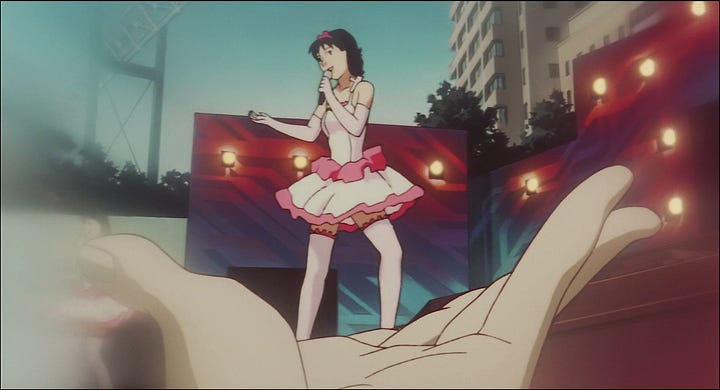
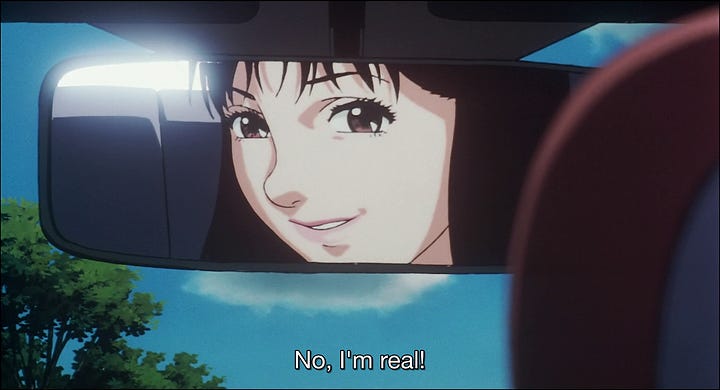
All the symbolic depth Perfect Blue presents is paired with a formal excellence in terms of plot structure that should be seen to be believed. This structure elevates the plot twist from its critical degradation to the importance Aristotle designates to it.
Weekly Reading List
Jim Davis has been taking his youtube viewers behind the curtain of Pro Tour testing quite a bit over the past few years, but this is more or less a fully produced documentary by Jim and his team following Davis and Reid Duke through their Pro Tour preparation. I loved it.
Event Calendar: Happyend is still in theaters.
Go see Happyend (2025). It is the best movie you’ll see this year.
Until next time.


